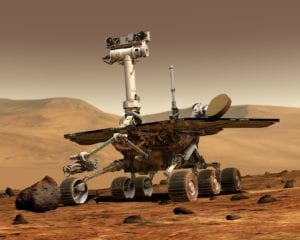Today Mars is a largely dry planet. But in the past – as numerous studies have shown – Mars also had liquid water. An international research team led by Geronimo Villanueva from NASA’s Goddard Space Flight Center in Greenbelt, USA, has now presented a two-dimensional map of the isotopic composition of water in the Martian atmosphere for the first time in the journal “Science”. From this map it can be concluded how large the primordial ocean of Mars must have been.
In nature, water does not only consist of the molecule H2O, but also contains small amounts of the so-called semi-heavy water, also called HDO: Molecules in which one of the hydrogen nuclei is replaced by a deuterium nucleus. These molecules are almost six percent heavier than normal water molecules – accordingly they evaporate more slowly and escape into space more slowly than H2O. The more water a celestial body has lost along this path in the course of its history, the more HDO in relation to H2O should be found on it.
This is where the work of Villanueva and colleagues comes in: Using spectrographs at the ESO’s Very Large Telescope in Chile, the Keck Telescope and the Infrared Telescope Facility – both in Hawaii – they studied the chemical composition of the Martian atmosphere over a period of six years and for the first time produced two-dimensional maps of the ratio of HDO to H2O.
The result of their observations: Compared to Earth, Mars has seven times more semi-heavy water. Mars must therefore have lost considerable amounts of water. The researchers estimate the amount of water at 23 million cubic kilometers. This corresponds to an ocean that could cover all of Mars to a depth of 137 meters. In reality, however, such an ocean would follow the topography of the planet and cover almost half of the northern hemisphere – with water depths of up to 1.6 kilometers.
Ulli Käufl, an ESO scientist responsible for the construction of the CRIRES instrument used to record the data at the VLT, summarizes the result: “We have found a former ocean at a distance of one hundred million kilometers! In the future, the mapping could also help to find remnants of water on the surface of Mars that may have escaped into space under the cap rock.





